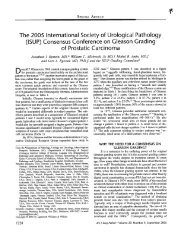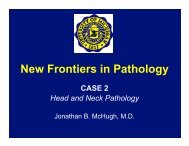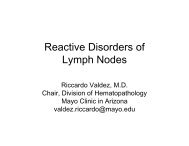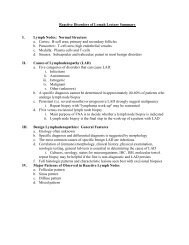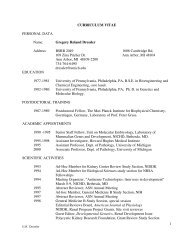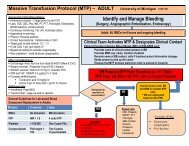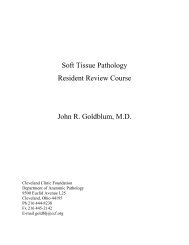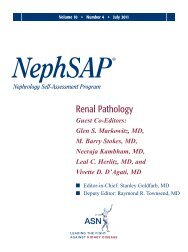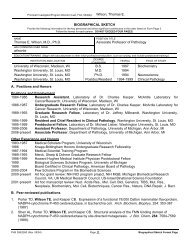Bone Tumor Pathology
Bone Tumor Pathology
Bone Tumor Pathology
You also want an ePaper? Increase the reach of your titles
YUMPU automatically turns print PDFs into web optimized ePapers that Google loves.
<strong>Bone</strong> <strong>Tumor</strong> <strong>Pathology</strong><br />
Carrie Y. Inwards, MD<br />
MMayo Cli Clinic i<br />
Rochester Rochester, MN
<strong>Bone</strong> <strong>Tumor</strong>s<br />
• Benign Benign, malignant, malignant or non-<br />
neoplastic<br />
• Primary, secondary, or<br />
metastatic<br />
CP1059536-1
<strong>Bone</strong> <strong>Tumor</strong>s<br />
Classification<br />
• Cl Classified ifi d according di tto cytology t l or<br />
products of the lesional cells<br />
• Chondroid or osteoid: Chondrosarcoma,<br />
osteosarcoma, etc<br />
• Fibrogenic: MFD, fibrosarcoma, etc<br />
• Notochord: Chordoma<br />
CP1059536-3
Cartilage <strong>Tumor</strong>s<br />
• Benign<br />
• Osteochondroma<br />
• Enchondroma<br />
• Ch Chondroblastoma<br />
d bl t<br />
• Chondromyxoid fibroma<br />
• Malignant<br />
• Chondrosarcoma
Osteochondroma<br />
• Benign outgrowth of cortical and<br />
medullary bone (“exostosis”)<br />
• 33% of benign bone tumors<br />
• 10% of all bone tumors<br />
• Majority ajo ty are a e solitary so ta y lesions es o s (spo (sporadic) ad c)<br />
• Multiple hereditary exostosis<br />
( (autosomal t l ddominant i t di disorder)<br />
d )<br />
CP1059536-4
Osteochondroma<br />
• 60% of patients p proximal humerus ><br />
proximal i l tibi tibia<br />
• Solitary y lesions uncommon in small<br />
bones<br />
CP1059536-6
Osteochondroma<br />
Radiographic Features<br />
• Cortex and medullary cavity continuous<br />
with the underlying bone<br />
• Often arise at the site of tendon<br />
insertions ( (direction of f growth along line<br />
of tendon)
Osteochondroma<br />
Gross <strong>Pathology</strong><br />
• Sessile or pedunculated<br />
• Thin, regular, blue/grey cap (usually < 2<br />
cm)<br />
• Underlying cancellous bone<br />
• May be associated with a bursa<br />
CP1059536-8
CP1059536-5
CP1059536-9
CP1059536-10
Osteochondroma<br />
Histologic Findings<br />
• Cartilage cap<br />
• Chondrocytes in lacunae arranged in<br />
clusters peripherally and in columns<br />
near base of cap cap, simulating normal<br />
epiphyseal plate<br />
• Stalk<br />
• Cancellous bone surrounded by fat<br />
and dbbone<br />
marrow
Stalk<br />
Cartilage Cap<br />
Osteochondroma<br />
CP1059536-11
Chondrocytes arranged in<br />
columns at base of<br />
cartilage cap<br />
Osteochondroma
Osteochondroma<br />
Differential Diagnosis<br />
• Parosteal osteosarcoma<br />
• Chondrosarcoma arising in<br />
osteochondroma<br />
• Bizzare parosteal osteochondromatous<br />
proliferation (Nora’s lesion)<br />
• HHeterotopic t t i ossification ifi ti<br />
• Subungual exostosis
Osteochondroma<br />
Treatment<br />
• Surgical excision if lesion is<br />
symptomatic<br />
y p
Enchondroma<br />
• Benign, g , intramedullary, y, hyaline y cartilage g<br />
tumor<br />
• 16% of benign bone tumors<br />
• 60% of pts are between 15 and 40 yr of age<br />
• 50% located in the small bones (hands, feet)<br />
• MMost t commonly l a solitary lit ttumor<br />
CP1059536-12
Multiple Enchondromas<br />
• Ollier disease<br />
• Multiple enchondromas involving the entire<br />
skeleton, half of the body, or one limb<br />
• Non-hereditary disorder<br />
• May show increased cellularity<br />
• Maffucci’s syndrome:<br />
• MMultiple lti l enchondromas h d with ith soft ft ti tissue<br />
hemangiomas<br />
Increased risk of de eloping<br />
• Increased risk of developing<br />
chondrosarcoma (~ 35%)
Enchondroma<br />
Radiographic Features<br />
• Intramedullary area of rarifaction<br />
• Variable mineralization<br />
• Long bones:<br />
• Usually no cortical erosion or destruction<br />
• Small bones:<br />
• Cortex may be thinned and expanded
CP1059536-14
CP1059536-16
Enchondroma<br />
Gross Features<br />
• Usually curetted lobulated fragments of<br />
grey/white g y tissue<br />
• No significant myxoid or mucoid quality
Enchondroma<br />
Histologic Features<br />
• Long and flat bones<br />
• Hypocellular; occasional moderately<br />
cellular areas<br />
• Bland cytologic y g features<br />
• Occasionally degenerative changes<br />
• Small bones<br />
• Moderately cellular, increase in nuclear<br />
size size, variable myxoid change<br />
• No invasion of medullary or cortical bone
Enchondroma abutting cortical bone – no evidence of invasion
Enchondroma – lobules of cartilage filling the marrow
Enchondroma in a long bone: hypocellular; no atypia
Enchondroma in a small bone: increased cellularity<br />
and nuclear enlargement
Enchondroma<br />
Differential Diagnosis<br />
• Chondrosarcoma<br />
• Overall increased cellularity &<br />
cytologic atypia<br />
• Frequent permeation of cortical bone bone,<br />
entrapment of host bone<br />
• MMore aggressive i radiographic di hi<br />
features
• Curettage/grafting<br />
Enchondroma<br />
Treatment
Chondroblastoma<br />
• 1.4% of primary bone tumors<br />
• 5% of benign bone tumors<br />
• 60% involve long tubular bones<br />
• Di Distal t l ffemur > proximal i l hhumerus<br />
><br />
proximal tibia<br />
• 60% in second decade of life
Chondroblastoma<br />
Radiographic Features<br />
• Benign radiographic<br />
appearance<br />
• Lucent defect at the end<br />
of the bone<br />
• 40% confined to the<br />
epiphysis<br />
• 60% in epiphysis and<br />
metaphysis<br />
• 50% have a sclerotic rim
Chondroblastoma<br />
Histologic Features<br />
• Mononuclear cells with well-defined<br />
cytoplasmic y p boundaries, , oval-to<br />
elongated nucleus, eosinophilic<br />
cytoplasm y p<br />
• 95% contain cartilage matrix (usually<br />
pink)<br />
• 35% contain lace-like (“chicken wire”)<br />
calcification<br />
• Multinucleated giant cells common
Chondroblastoma: lobules of pink chondroid matrix<br />
surrounded by mononuclear cells
Chondroblastoma: cells with oval nuclei, eosinophilic cytoplasm,<br />
well defined cytoplasmic boundaries
Chondroblastoma: lobule of pink – blue chondroid matrix and<br />
multinucleated giant cells
Chondroblastoma with chunky (left) and “chicken wire” (right)<br />
calcification
Chondroblastoma<br />
• Differential Diagnosis<br />
• Giant cell tumor<br />
• Chondromyxoid fibroma<br />
• OOsteosarcoma t<br />
• Treatment<br />
• Curettage and bone graft
Chondromyxoid Fibroma<br />
• 0.5% of bone tumors<br />
• 11.6% 6% of benign bone tumors<br />
• Peak incidence in second and third<br />
decades<br />
• 45% occur in the long bones<br />
• Proximal tibia > distal femur<br />
• Flat bones: ilium and ribs<br />
• 30% in hands and feet
Chondromyxoid Fibroma<br />
Radiographic Features<br />
• Benign appearance<br />
• Usually y<br />
metaphyseal<br />
• Eccentrically located<br />
• Circumscribed<br />
• Scalloped p<br />
appearance with<br />
sclerotic rim
Chondromyxoid Fibroma<br />
Histologic Features<br />
• Lobulated growth pattern<br />
• Macrolobules or microlobules<br />
• Cells with small oval to spindle<br />
shaped nuclei and pink cytoplasmic<br />
extensions<br />
• CCellular ll l proliferation lif ti of f oval l tto spindle i dl<br />
shaped cells and multinucleated giant<br />
cells ll surround d llobules b l
Chondromyxoid fibroma: macrolobular growth pattern
Chondromyxoid fibroma: Microlobular growth pattern
Chondromyxoid fibroma: microlobular growth pattern
Chondromyxoid fibroma: cells with small nuclei and cytoplasmic<br />
extensions
Chondromyxoid Fibroma<br />
• Differential diagnosis<br />
• Chondroblastoma<br />
• Chondrosarcoma<br />
• TTreatment t t<br />
• Curettage
Chondrosarcoma<br />
• Conventional chondrosarcoma<br />
• Dedifferentiated chondrosarcoma<br />
• Clear Cell chondrosarcoma<br />
• MMesenchymal h l chondrosarcoma<br />
h d
Chondrosarcoma<br />
• Males > females<br />
• 60% in 4th to 6th 60% in 4 to 6 decades of life<br />
• Two thirds located in pelvic and<br />
shoulder girdles and upper ends of the<br />
femur and humerus<br />
• < 3% distal di t l to t wrist i t and d ankle<br />
kl
Chondrosarcoma<br />
Radiographic Features<br />
• Usually large (ave. size 9.5 cm)<br />
• 75% are mineralized<br />
• Poorly marginated<br />
• 85% show h cortical ti l abnormalities<br />
b liti<br />
• Endosteal scalloping, cortical<br />
destruction, expansion of the bone<br />
• 40% with soft tissue mass
CP1059536-21
Chondrosarcoma arising secondary in enchondroma (Ollier<br />
Disease)
Chondrosarcoma<br />
Gross Features<br />
• Lobulated, pale<br />
blue/white<br />
• Solid or partially cystic<br />
• Myxoid change<br />
common<br />
• Degenerative change<br />
and necrosis<br />
• Permeative
CP1059536-23
CP1059536-25
Chondrosarcoma<br />
Histologic Features<br />
• Hypercellular, nuclear enlargement and<br />
hyperchromasia<br />
• Permeation of cortical and medullary<br />
bone<br />
• Liquifactive myxoid change in matrix<br />
• Small bones: permeation required<br />
• Grades 1, 2, & 3
Chondrosarcoma: malignant cartilage permeating between host<br />
bone<br />
CP1059536-29
Chondrosarcoma: hypercellular and nuclear atypia
Chondrosarcoma: permeative growth pattern
Chondrosarcoma: myxoid change in the matrix
Grade 1 Chondrosarcoma
Grade 2 Chondrosarcoma
Grade 3 Chondrosarcoma
Chondrosarcoma in a small bone permeating into<br />
soft tissue
Chondrosarcoma<br />
Treatment<br />
• Surgery: wide resection<br />
• Not responsive to chemotherapy and<br />
radiation
Chondrosarcoma of Long <strong>Bone</strong>s,<br />
Shoulder Girdle and Pelvis<br />
% with<br />
metastasis<br />
Survival Free of Metastasis<br />
100<br />
80<br />
60<br />
metastasis Grade Grade 2 + 3<br />
40<br />
20<br />
0<br />
Grade Grade 1<br />
0 2 4 6 8 10 12 14 16 18 20<br />
Years from Mayo diagnosis<br />
CP1059536-35
Dedifferentiated<br />
Chondrosarcoma<br />
• Occurs in 2 settings<br />
• De novo<br />
• In recurrent tumors<br />
• Old Older adults d lt ( (a ddecade d older ld th than<br />
conventional chondrosarcoma)<br />
• Pelvis and shoulder girdle most<br />
common sites
Dedifferentiated Chondrosarcoma<br />
Radiographic Features<br />
• Oftentimes suggests<br />
dedifferentiation<br />
• Central portion has<br />
features of a<br />
cartilage til ttumor<br />
• Cortical and soft<br />
ti tissue portions ti<br />
usually look more<br />
aggressive
Dedifferentiated Chondrosarcoma
Dedifferentiated Chondrosarcoma<br />
• Blue/grey cartilage<br />
tumor juxtaposed to<br />
a fleshy, tan/white<br />
sarcomatous tumor<br />
• VVariable i bl amounts t of f<br />
2 components<br />
• CCareful f l sampling!<br />
li !<br />
Gross Features
Dedifferentiated Chondrosarcoma<br />
Histologic Features<br />
• Bimorphic pattern<br />
• Low-grade Low grade chondrosarcoma<br />
juxtaposed to a high grade sarcoma<br />
• High grade sarcoma<br />
• Osteosarcoma, high grade spindle<br />
cell ll sarcoma, pleomorphic l hi<br />
undifferentiated sarcoma
Dedifferentiated Chondrosarcoma: low-grade malignant<br />
cartilage (left); high-grade osteosarcoma (right)
Dedifferentiated Chondrosacoma<br />
• Treatment<br />
• En bloc resection<br />
• +/- chemotherapy<br />
• PPrognosis i<br />
• Worse than conventional<br />
chondrosarcoma<br />
• 5 year y<br />
survival 10%
Clear Cell Chondrosarcoma<br />
• Extremely uncommon<br />
• Tends to involve the ends of the long<br />
bones (proximal femur and humerus)<br />
• Male predilection<br />
• 4th and 5th decades of life
Clear Cell Chondrosarcoma<br />
Radiographic Features<br />
• Lytic, extending to<br />
the end of the<br />
bone<br />
• Occasionally has<br />
a benign<br />
appearance<br />
•
Clear Cell Chondrosarcoma<br />
Histologic Features<br />
• Lobulated growth pattern<br />
• <strong>Tumor</strong> cells have distinct cytoplasmic<br />
boundaries, central nucleus with<br />
prominent nucleolus, nucleolus clear cytoplasm<br />
• Trabeculae of woven bone commonly<br />
present<br />
• 50% of tumors contain nodules of<br />
conventional ti l chondrosarcoma<br />
h d
Clear cell chondrosarcoma: clear cells and hyaline cartilage
Clear cell chondrosarcoma: cells with clear cytoplasm and<br />
multinucleated giant cells
Clear cell chondrosarcoma
Clear Cell Chondrosacoma<br />
Differential Diagnosis<br />
• Chondroblastoma<br />
• Osteoblastoma<br />
• Osteosarcoma
Mesenchymal Chondrosarcoma<br />
• 2/3 in bone; 1/3 in soft tissue<br />
• 50% in 2nd and 3rd 50% in 2 and 3 decades<br />
• Jaw bones common site<br />
• Ili Ilium, spine, i ribs<br />
ib
Mesenchymal Chondrosarcoma<br />
• Malignant radiographic appearance<br />
• Histologic features<br />
• Well differentiated hyaline cartilage<br />
merging or juxtaposed with highgrade<br />
small blue cell component
Malignant cartilage<br />
Small blue cells<br />
Mesenchymal Chondrosarcoma
<strong>Bone</strong>-Forming <strong>Tumor</strong>s<br />
• Benign<br />
• Osteoid osteoma<br />
• Osteoblastoma<br />
• MMalignant li t<br />
• Osteosarcoma
Osteoid Osteoma<br />
• Size < 1.5 cm<br />
• Most common in adolescents and<br />
young adults<br />
• Three fourths of patients are between<br />
5 and 24 yrs<br />
• PPainful; i f l relieved li d with ith NSAID’s NSAID’<br />
• Most common sites is the proximal<br />
femur
Osteoid Osteoma<br />
Radiographic Findings<br />
• Sclerosis and<br />
new bone<br />
surround the<br />
lesion<br />
• Small round nidus<br />
in cortex<br />
• CT helpful in<br />
identifying the<br />
nidus
• Well demarctated<br />
red/brown nidus<br />
• Surrounding<br />
sclerotic l ti or<br />
cortical bone<br />
Osteoid Osteoma<br />
Gross Features<br />
CP1059536-66
Osteoid Osteoma<br />
Histologic Features<br />
• Irregular trabeculae of woven bone<br />
surrounded by y loose fibrovascular<br />
stroma<br />
• Multinucleated giant cells common<br />
• Nidus sharply demarcated from<br />
surrounding bone
Nidus<br />
Osteoid osteoma: central nidus surrounded by trabeculae of bone
Osteoid osteoma: nidus with woven bone rimmed by osteoblasts
Osteoid Osteoma<br />
Treatment<br />
• Radiofrequency ablation<br />
• Surgical excision<br />
• Histologic confirmation of nidus
Osteoblastoma<br />
• Same histologic features as osteoid<br />
osteoma<br />
• > 2 cm<br />
• 75% of patients are under 25 yrs of age<br />
• Long bones > spine (body/dorsal<br />
elements) l t ) > jawbones<br />
j b
Osteoblastoma<br />
Radiographic Features<br />
• Variable and nonspecific<br />
p<br />
• 25% simulate<br />
malignancy
• Tan/red-brown,<br />
friable<br />
• Well demarcated<br />
Osteoblastoma<br />
Gross Features
Osteoblastoma: trabeculae of woven bone surrounded<br />
by fibrovascular tissue
Osteoblastoma: woven bone, osteoblasts, fibrovascular stroma
Osteoblastoma: solid areas of bone production
Osteoblastoma<br />
Differential Diagnosis<br />
• Osteosarcoma<br />
• Can be very difficult to make the<br />
distinction<br />
• Osteoid osteoma<br />
• ABC<br />
• Giant cell tumor
Osteosarcoma<br />
• Medullary<br />
• Conventional osteosarcoma<br />
• Surface<br />
• PParosteal t l osteosarcoma<br />
t<br />
• Periosteal osteosarcoma<br />
• High grade surface osteosarcoma
Osteosarcoma<br />
• Second most common malignant bone<br />
tumor<br />
• Mayo Clinic<br />
• 23% of primary bone tumors<br />
• 30% of primary p y malignant g<br />
tumors
Osteosarcoma<br />
• 85% before 30 years of age<br />
• Distal femur > proximal tibia > proximal<br />
humerus > proximal p femur<br />
• Metaphyseal region of the long bones
Osteosarcoma<br />
Radiographic Features<br />
• Aggressive,<br />
destructive features<br />
• “Codman’s triangle”<br />
• Lytic Lytic, sclerotic<br />
• MRI and CT aid in<br />
evaluating l ti extent t t of f<br />
tumor
CP1059536-43
CP1059536-48
CP1059536-55
Chondroblastic Osteosarcoma<br />
CP1059536-53
Osteosarcoma<br />
Histologic Subtypes<br />
• Osteoblastic, chondroblastic,<br />
fibroblastic fibroblastic, telangiectatic telangiectatic, low low-grade grade<br />
central, giant cell rich, small cell<br />
• 85% % are high grade
Osteoblastic Osteosarcoma: permeating between host trabeculae
Osteoblastic Osteosarcoma: malignant osteoid in a lace-like<br />
pattern surrounding anaplastic tumor cells<br />
CP1059536-50
Chondroblastic Osteosarcoma: malignant osteoid and cartilage
Fibroblastic Osteosarcoma: malignant spindle cell stroma<br />
and bone<br />
CP1059536-56
Telangiectatic Osteosarcoma: fragments of cyst wall<br />
containing pleomorphic tumor cells<br />
CP1059536-49
Osteosarcoma<br />
Treatment<br />
• Preoperative chemotherapy<br />
• Wide surgical resection<br />
• Postoperative chemotherapy
Fig 1. Event-free survival (EFS) and overall survival for<br />
patients newly diagnosed with osteosarcoma without<br />
clinically detectable metastatic disease<br />
Copyright Meyers, © American P. Society A. et of Clinical al. Oncology J Clin Oncol; 26:633-638 2008
OGS: Histologic % Necrosis s/p<br />
Neoadjuvant Chemotherapy<br />
• Important prognostic indicator<br />
• Huvos grading system<br />
• Grade 1: 90% necrosis: Good prognosis<br />
• < 90% necrosis: Poorer prognosis
Necrotic osteosarcoma following neoadjuvant chemotherapy
Low-Grade Osteosarcoma<br />
• Low-grade central (intramedullary)<br />
• Extremely rare<br />
• Radiographs show areas with<br />
aggressive features<br />
• Parosteal osteosarcoma
Parosteal Osteosarcoma<br />
• 4% of all osteosarcomas<br />
• Most common in young adults<br />
• Distal femur > proximal tibia > proximal<br />
humerus<br />
• posterior cortex of the distal femoral<br />
metaphysis t h i most t common site it<br />
• Treatment is wide resection without<br />
chemotherapy
Parosteal Osteosarcoma<br />
Radiographic Features<br />
• Heavily mineralized mass attached by a<br />
broad base to the underlying y g cortex<br />
• CT and MRI helpful in identifying<br />
whether there is medullary involvement
Parosteal Osteosarcoma<br />
Histologic Features<br />
• Well formed trabeculae of bone<br />
• Spindle cells with minimal atypia<br />
• Cartilaginous differentiation in about half<br />
of tumors; occasionally in a “cap” cap<br />
• 15% contain a high-grade sarcoma<br />
(d (dedifferentiated diff ti t d parosteal t l<br />
osteosarcoma)
Parosteal osteosarcoma: long trabeculae of bone (left)<br />
surrounded by spindle cell stroma with minimal atypia
Periosteal Osteosarcoma<br />
• Chondroblastic, moderately<br />
differentiated osteosarcoma on the<br />
surface of bone<br />
• 11.5% 5% of osteosarcomas<br />
• Children and adolescents<br />
• Di Diaphysis h i of f ffemur and d tibi tibia
Periosteal Osteosarcoma: histologically chondroblastic<br />
osteosarcoma (right)
Fibrogenic <strong>Tumor</strong>s<br />
• Fibrous dysplasia<br />
• Metaphyseal fibrous defect (non- (non<br />
ossifying fibroma)
Fibrous Dysplasia<br />
• Non-familial somatic mutation<br />
• Biology driven by activating oncogenic<br />
mutations of GNAS1 gene<br />
• Monostotic (80%) or polyostotic (20%)
Fibrous Dysplasia<br />
• McCune Albright Syndrome<br />
• 3% of patients<br />
• Polyostotic fibrous dysplasia<br />
• Endocrine abnormalities<br />
• Cutaneous pigmentation<br />
• Mazabraud’s Mazabraud s syndrome<br />
• Very rare<br />
• Fib Fibrous ddysplasia l i<br />
• Soft tissue myxoma
Fibrous Dysplasia<br />
• 75% diagnosed before 30 yrs of age<br />
• Femoral neck is the most common site<br />
• 1/3 in the craniofacial bones, 1/3 in the<br />
femur or tibia, and 20% in the ribs
Fibrous Dysplasia<br />
Radiographic Features<br />
• Well defined zone<br />
of rarefaction<br />
• Sclerotic rim<br />
• Mineralization:<br />
“ground glass”<br />
appearance
CP1059536-81
CP1059536-79
CP1059536-80
Fibrous Dysplasia<br />
Histologic Features<br />
• Irregular spicules of<br />
woven bone<br />
• Bland spindle cells<br />
• Occasionally foam<br />
cells, myxoid<br />
change change, fibrosis
Fibrous Dysplasia
Fibrous Dysplasia<br />
CP1059536-83
Fibrous Dysplasia<br />
Treatment<br />
• Observation if asymptomatic<br />
• Curettage and grafting<br />
• Resection in some cases<br />
• LLocal l recurrence iis possible ibl<br />
• Polyostotic may be progressive
Metaphyseal Fibrous Defect<br />
• Also known as non-ossifying fibroma<br />
• Cortex or cortex and medullary cavity<br />
• 80% in the distal femur, distal tibia, and<br />
proximal tibia<br />
• Seen in as many as 35% of children
Metaphyseal Fibrous Defect<br />
Radiographic Features<br />
• Metaphyseal,<br />
eccentric<br />
• Sclerotic margin margin,<br />
circumscribed<br />
• Often diagnosed<br />
by x-ray alone
CP1059536-92
Metaphyseal Fibrous Defect<br />
Histologic Features<br />
• Plump spindle cells in a loose storiform<br />
pattern p<br />
• Multinucleated giant cells, foam cells,<br />
chronic inflammation<br />
• Mitotic activity
Metaphyseal fibrous defect: hypercellular fibrogenic stroma,<br />
multinucleated giant cells
Metaphyseal Fibrous Defect<br />
CP1059536-93
Metaphyseal Fibrous Defect<br />
• Most are small and may regress<br />
spontaneously<br />
p y<br />
• Symptomatic, large, or atypical lesions<br />
are biopsied and treated surgically
Ewing Sarcoma<br />
• Fourth most common primary tumor of<br />
bone<br />
• Male predilection<br />
• 75% in the first 2 decades of life<br />
• 60% in pelvic girdle and lower<br />
extremities t iti<br />
• Femur > ilium > fibula
Ewing Sarcoma<br />
Radiographic Features<br />
• Permeative,<br />
destructive, poorly<br />
defined margins<br />
• Periosteal new bone<br />
fformation ti “onion “ i<br />
skin” appearance<br />
• Di Diaphysis h i &<br />
metaphysis
Ewing Sarcoma<br />
Histologic Features<br />
• Small, round cell malignancy<br />
• Sheet-like Sheet like growth pattern in bone<br />
marrow; lobular or fillagree in soft tissue<br />
• Oval or round nuclei surrounded by<br />
clear or indistinct eosinophilic cytoplasm
Ewing Sarcoma<br />
Histologic Subtypes<br />
• Classic / conventional / typical: ~ 70%<br />
• Pi Primitive iti neuroectodermal t d lttumor<br />
(PNET): ~ 15%<br />
• Atypical: ~ 15 – 20%
Ewing Sarcoma<br />
Histologic Subtypes<br />
• Morphologic variation<br />
• Identical immunohistochemical and<br />
genetic features
Conventional Ewing Sarcoma: small blue cells with scant cytoplasm
Atypical Ewing Sarcoma: more cytologic variability
PNET: rosette formation
Ewing Sarcoma<br />
Immunohistochemistry<br />
• CD99 is the most helpful marker<br />
• SSensitive; iti not t 100% specific ifi<br />
• CD99: 95%<br />
• Keratin: 32%<br />
• FLI-1: FLI 1: 94%
Ewing Sarcoma<br />
Genetics<br />
• Most common translocation and fusion<br />
genes g<br />
• t(11;22)(q24;q12) EWSR1-FLI1 (95%)<br />
• t(21;22)(q22;q12) EWSR1 EWSR1-ERG ERG (5%)<br />
• Others (
Ewing Sarcoma<br />
Differential Diagnosis<br />
• Primary consideration is lymphoma<br />
• Panel of immunostains is essential<br />
• T and B- cell markers: lymphoma<br />
• CD99 positive: iti EEwing i sarcoma and d<br />
lymphoblastic lymphoma
• Treatment<br />
Ewing Sarcoma<br />
• Neo-adjuvant chemotherapy<br />
• Wide resection<br />
• Adjuvant j chemotherapy py<br />
• +/- radiation<br />
• Histologic response to neo neo-adjuvant adjuvant<br />
chemotherapy<br />
• IImportant t t predictor di t of f survival<br />
i l
Ewing Sarcoma<br />
Prognosis<br />
• Grier et al NEJM; Feb 2003<br />
• 5 year event free survival: 70%<br />
• Overall survival: 72%<br />
• Child Children’s ’ oncology l group (COG): (COG)<br />
every-two week vs every-3-week<br />
chemotherapy h th cycles l show h an iimproved d<br />
(90%) overall survival
Ewing Sarcoma<br />
• Poor prognostic factors<br />
• Older age (>17 yrs)<br />
• Pelvic tumor<br />
• LLarge t tumor ( (>8 8 cm) )<br />
• Metastatic disease
Giant Cell <strong>Tumor</strong><br />
• BBenign, i llocally ll aggressive i<br />
• 20% of benign bone tumors<br />
• Majority are solitary; may be multiple<br />
• Most common in 3 to 5th decades<br />
• Female predilection
Giant Cell <strong>Tumor</strong><br />
• Most common in the end (epiphysis) of<br />
the long g bones<br />
• Distal femur > proximal tibia > distal<br />
radius > sacrum<br />
• Anterior elements more common when<br />
located in the mobile spine
Giant Cell <strong>Tumor</strong><br />
Radiographic Features<br />
• Eccentric, purely lytic,<br />
end of bone<br />
• Cortical destruction,<br />
soft tissue mass with<br />
shell of bone<br />
• One fourth look<br />
aggressive
CP1059536-123
CP1059536-127
Giant Cell <strong>Tumor</strong><br />
Histologic Findings<br />
• Numerous multinucleated giant cells<br />
scattered throughout g the tumor<br />
• Mononuclear cells with round to oval<br />
nuclei and eosinophilic cytoplasm<br />
• Mitotic activity<br />
• FFoam cells, ll reactive ti new bbone,<br />
occasional spindle cell areas,<br />
secondary d ABC
Giant Cell <strong>Tumor</strong>: numerous multinucleated giant cells
Giant cell tumor: stromal cells resemble cells in multinucleated<br />
giant cells
Giant cell tumor<br />
CP1059536-125
Giant cell tumor: spindle-shaped and oval-shaped stromal cells
Giant Cell <strong>Tumor</strong><br />
necrosis
Giant Cell <strong>Tumor</strong><br />
Treatment<br />
• Curettage if the joint surfaces can be<br />
saved<br />
• Resection/reconstruction if joint<br />
surfaces can not be saved<br />
• Occasionally chemical cautery or<br />
cryosurgery
Aneurysmal <strong>Bone</strong> Cyst<br />
• May arise primary or secondarily in<br />
other tumors (most ( commonly y benign g<br />
tumors)<br />
• Most common in first and second<br />
decades of life; 50% in second decade<br />
• Most common sites are distal femur and<br />
proximal tibia; usually in the metaphysis<br />
• IIn the th spine, i the th posterior t i elements l t are<br />
most commonly affected
Aneurysmal <strong>Bone</strong> Cyst<br />
Radiographic Findings<br />
• Lucency in the<br />
metaphysis of long<br />
bones<br />
• May be eccentric,<br />
central, t l cortical, ti l or<br />
surface of bone<br />
• CCortex t may be b<br />
destroyed<br />
• Fluid Fluid-fluid fluid levels<br />
common
• Red-brown<br />
Aneurysmal <strong>Bone</strong> Cyst<br />
• Solid or cystic<br />
Gross Features
Aneurysmal <strong>Bone</strong> Cyst<br />
Histologic Findings<br />
• Multiple cystic spaces separated by<br />
septa; p ; occasionally y “solid”<br />
• Fibrous septa composed of spindle cells<br />
without atypia, atypia mitotic activity activity,<br />
multinucleated giant cells; no<br />
endothelial lining<br />
• Osteoid and bony matrix (woven bone)<br />
may be present<br />
• Calcification frequently seen
ABC with cystic spaces surrounded by cellular septa
ABC: loose fibroblastic stroma of cyst wall, no cytologic<br />
atypia, multinucleated giant cells
Solid area of ABC with reactive bone and fibrous stroma
Anerurysmal <strong>Bone</strong> Cyst<br />
• Differential Diagnosis<br />
• Telangiectatic osteosarcoma<br />
• Giant cell tumor<br />
• TTreatment t t<br />
• Curettage<br />
• Occasionally resection for large<br />
lesions
Unicameral <strong>Bone</strong> Cyst<br />
• Also known as simple cyst<br />
• Majority of patients are in the first two<br />
decades of life<br />
• Pathologic fractures common<br />
• Proximal humerus and proximal femur<br />
are most t common sites<br />
it
Unicameral <strong>Bone</strong> Cyst<br />
Radiographic Findings<br />
• Located centrally in<br />
the medullary cavity<br />
abutting the<br />
epiphyseal plate<br />
• NNo wider id th than<br />
epiphyseal plate<br />
• Thi Thinned, d bbut t iintact t t<br />
cortex<br />
• Trabeculation
Unicameral <strong>Bone</strong> Cyst<br />
Histologic Findings<br />
• Cyst wall fragments with bland spindle<br />
cells admixed with fragments g of bone<br />
• Irregular masses of degenerating fibrin<br />
that occasionally become calcified
UBC: fragments of bland cyst wall and bone
UBC containing eosinophilic fibrin
Unicameral <strong>Bone</strong> Cyst<br />
Treatment<br />
• Most are aspirated and injected with<br />
methylprednisolone<br />
yp<br />
• Occasionally curetted
Chordoma<br />
• Malignant tumor arising from notochord<br />
remnants<br />
• 6 % of malignant bone tumors<br />
• Males > females (2:1)<br />
• Most patients in the 5th to 7th decades<br />
• Patients with base of skull lesions<br />
generally a decade younger
Chordoma<br />
• Anatomic location<br />
• Sacrum: 50%<br />
• Base of skull: 37%<br />
• MMobile bil spine: i 13%
Chordoma<br />
Radiographic Findings<br />
• Often difficult to see in plain radiographs<br />
• CT & MRI most helpful in delineating<br />
the tumor<br />
• Lytic Lytic, destructive destructive, frequent soft tissue<br />
mass
• Lobulated<br />
• Gray-tan Gray tan, red- red<br />
brown, glistening,<br />
translucent<br />
Chordoma<br />
Gross Findings
Chordoma<br />
Histologic Findings<br />
• Lobules separated by fibrous septa<br />
• Cords and nests of tumors cells in a<br />
pale blue myxoid background<br />
• Round nuclei with central nucleoli<br />
• Eosinophilic or clear cytoplasm with<br />
prominent i t iintracytoplasmic t t l i<br />
vacuolization (physaliphorous cell)<br />
• Chondroid chordoma
Chordoma<br />
Immunohistochemical Stains<br />
• Keratin positive<br />
• EMA positive iti<br />
• Brachyury positive
Chordoma: lobulated growth pattern
Chordoma: cells with round nuclei & vacuolated cytoplasm<br />
arranged in cords
Metastatic <strong>Bone</strong> <strong>Tumor</strong>s<br />
• More common than primary bone<br />
tumors; ; carcinoma most common type yp<br />
• Adults: 80% are from lung, kidney,<br />
breast breast, prostate<br />
• Children: neuroblastoma, Wilm’s, OGS,<br />
Ewing’s Ewing s, rhabdomyosarcoma<br />
• Spine, pelvis, ribs, skull, proximal long<br />
bones
Metastatic <strong>Bone</strong> <strong>Tumor</strong>s<br />
Radiographic Features<br />
• Lytic: kidney, GI,<br />
thyroid, y ,<br />
melanoma<br />
• Blastic: prostate<br />
• Both: breast, lung
CP1059536-114
CP1059536-113
Metastatic adenocarcinoma Metastatic squamous cell CP1059536-110 ca
Metastatic Breast Carcinoma<br />
CP1059536-116
Metastatic Renal Cell Carcinoma<br />
CP1059536-118
<strong>Bone</strong> <strong>Tumor</strong>s<br />
Conclusion<br />
• Care of the patient requires a<br />
multidisciplinary approach<br />
• Pathologist<br />
• RRadiologist di l i t<br />
• Orthopedic surgeon<br />
• Medical oncologist<br />
• Radiation oncologist
Question #1
Question #1<br />
• The most likely anatomic site for this tumor<br />
would be:<br />
• Sacrum<br />
• Epiphysis of the femur<br />
• Metaphysis of the femur<br />
• Posterior vertebrae<br />
• Ilium
Question #2
Question #2<br />
• All but one of the following are false<br />
about this tumor except: p<br />
• It is most commonly seen in young<br />
adults<br />
• It is responsive to chemotherapy<br />
• It commonly l involves i l th the small ll bbones<br />
• It is graded on a scale of 1 to 3
Question #3
Question #3<br />
• The most effective treatment of this<br />
tumor is:<br />
• Surgery alone<br />
• Curettage<br />
• Surgery and chemotherapy<br />
• Radiation and surgery
Question #4
Question #4<br />
• This tumor:<br />
• Most commonly occurs in the 5th to 6th Most commonly occurs in the 5 to 6<br />
decades of life<br />
• Rarely occurs in the small bones<br />
• Contains a macro or micro lobular<br />
growth th pattern tt<br />
• Is the most common benign tumor in<br />
children
Question Q<br />
#5
Question #5<br />
• A tumor this these histologic features:<br />
• Would be consistent with a periosteal<br />
osteosarcoma<br />
• Would be consistent with a parosteal<br />
osteosarcoma<br />
• IIs most t commonly l seen in i th the pelvic l i<br />
bones<br />
• Frequently contains a secondary<br />
aneurysmal bone cyst component
Question #6
Question #6<br />
• A common finding in this tumor is:<br />
• EWSR1-FLI1 EWSR1 FLI1 fusion gene<br />
• SYT-SSX fusion gene<br />
• t(X t(X;18)(p11;q11)<br />
18)( 11 11)<br />
• t(11;12)(q22;21)
Question #7
Question #7<br />
• The radiographic and histologic findings<br />
given for this lesion:<br />
• Fit well<br />
• Do not fit well since the tumor is most<br />
likely located in the metaphysis<br />
• Do not fit well since the tumor is<br />
uncommon iin the h di distal l radius di<br />
• Do not fit well since the tumor is not<br />
destroying the cortex
Question #8
Question #8<br />
• This tumor<br />
• Has histologic features that overlap<br />
with chondroblastoma<br />
• Is often associated with pain that is<br />
relieved with steroids<br />
• IIs oftentimes ft ti effectively ff ti l treated t t d with ith<br />
observation only<br />
• Is frequently located in the proximal<br />
femur
Question #9
Question #9<br />
• This tumor:<br />
• Is rarely seen in the ribs<br />
• Results from GNAS1 mutation<br />
• Sh Shows radiographic di hi ffeatures t similar i il<br />
to ground stones<br />
• Most commonly located at the end of<br />
a long bone
Question #10
Question #10<br />
• This lesion<br />
• Is also known as non-ossifying non ossifying fibroma<br />
• Is effectively treated with chemotherapy<br />
and surgery<br />
• Contains few mitotic figures<br />
• Only rarely presents with a pathologic<br />
fracture
Question #11
Question #11<br />
• This tumor is frequently:<br />
• Located in the metaphysis of the long<br />
bones<br />
• Located in the sacrum<br />
• Affects children<br />
• Cytokeratin negative
Question #12
• This lesion<br />
Question Q #12<br />
• Radiographically shows cortical and<br />
medullary continuity between the<br />
lesion and underlying bone<br />
• Commonly involves the small bones<br />
• Commonly evolves into secondary<br />
chondrosarcoma<br />
h d<br />
• Contains fibrous tissue diffusely<br />
surrounding bone within the stalk
Question #13
Question #13<br />
• Common histologic findings of this<br />
lesion include all but one of the<br />
following:<br />
• Mitotic activity<br />
• Reactive or woven bone<br />
• CCalcification l ifi ti<br />
• Cytologic atypia<br />
• Solid and cystic areas
Question Q<br />
#14
Question #14<br />
• This tumor<br />
• Frequently involves the small bones<br />
• Is commonly seen in children<br />
• Sh Shows radiographic di hi evidence id of f<br />
cortical thickening and scalloping<br />
• Commonly contains myxoid change<br />
within the matrix
Question #15
• This tumor<br />
Question Q #15<br />
• Is associated with a relatively good<br />
prognosis<br />
• Contains low-grade chondrosarcoma &<br />
high g ggrade sarcoma components p<br />
• Contains high-grade chondrosacoma &<br />
high grade sarcoma components<br />
• Contains two histologic components<br />
that merge imperceptively with one<br />
another
Question #16
Question #16<br />
• This tumor<br />
• Frequently involves the jaw bones<br />
• Frequently contains a high grade<br />
osteosarcoma component<br />
• Frequently contains a high grade<br />
cartilaginous til i component t<br />
• Is the most common malignant bone<br />
tumor of children



